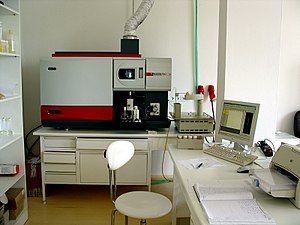
Back مطيافية الانبعاث الذري للبلازما المقترنة بالحث Arabic ICP-OES Czech طیفسنجی انتشار اتمی پلاسمای جفتشده القایی Persian Speictreascópacht astúcháin adamhaigh le plasma cúpláilte go hionduchtach Irish Induktív csatolású plazma atomemissziós spektrometria Hungarian Spektroskopi emisi atom plasma gandeng induktif ID 誘導結合プラズマ発光分析 Japanese Espectrometria de emissão atômica por plasma acoplado indutivamente Portuguese İndüksiyonla birleşmiş plazma atomik emisyon spektroskopisi Turkish 电感耦合等离子体原子发射光谱 Chinese

Inductively coupled plasma atomic emission spectroscopy (ICP-AES), also referred to as inductively coupled plasma optical emission spectroscopy (ICP-OES), is an analytical technique used for the detection of chemical elements. It is a type of emission spectroscopy that uses the inductively coupled plasma to produce excited atoms and ions that emit electromagnetic radiation at wavelengths characteristic of a particular element.[1] The plasma is a high temperature source of ionised source gas (often argon). The plasma is sustained and maintained by inductive coupling from electrical coils at megahertz frequencies. The source temperature is in the range from 6000 to 10,000 K. The intensity of the emissions from various wavelengths of light are proportional to the concentrations of the elements within the sample.
- ^ Thompson, Michael; Walsh, J. Nicholas (1989). "Handbook of Inductively Coupled Plasma Spectrometry". SpringerLink. doi:10.1007/978-1-4613-0697-9.
© MMXXIII Rich X Search. We shall prevail. All rights reserved. Rich X Search